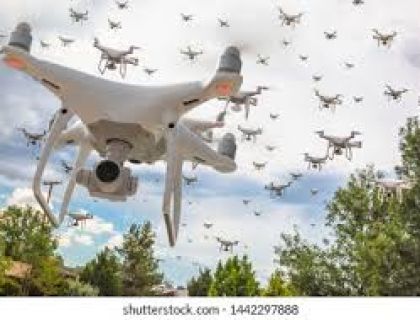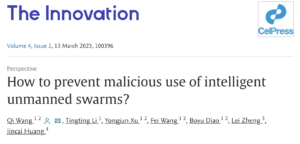Intelligent Unmanned Swarms

.
This is not a satire. We have to come to grips with such a world:
How to prevent malicious use of intelligent unmanned swarms?
.
.
Abstract
With advancements in swarm intelligence, artificial intelligence, and wireless mobile network technology, unmanned swarms such as unmanned aerial vehicles, ground vehicles, ships, and other unmanned systems are becoming increasingly autonomous and intelligent. Benefiting from these technologies, intelligent unmanned swarms are able to efficiently perform complex tasks through collaboration in various fields. However, malicious use of intelligent unmanned swarms raises concerns about the potential for significant damage to national infrastructures such as airports and power facilities. Defending against malicious activities is essential but challenging due to the swarms’ abilities to perceive, understand complex environments, and make accurate decisions through multi-system collaboration. This perspective sheds light on recent research in counter-measures and provides new trends and insights on how to prevent malicious actions by intelligent unmanned swarms.
Main text
The unmanned swarms are comprised of various unmanned systems, such as unmanned aerial vehicles, unmanned ground vehicles, and unmanned ships. These swarms are becoming more autonomous and intelligent due to advancements in swarm intelligence, artificial intelligence,1 and wireless mobile network technology. This allows intelligent unmanned swarms to have the capabilities of environment perception and awareness, task allocation, decision-making, and autonomous control through machine learning and collaboration among multiple agents. Specifically, unmanned systems equipped with electro-optical and thermal, as well as acoustic, radar can achieve comprehensive environmental awareness, recognition, and an overall understanding of the environment. Based on the large amount of data generated through interactions of unmanned systems, efficient task allocation and trajectory planning decisions are made to collaboratively complete complex tasks in various applications.
Intelligent unmanned swarms have a wide range of uses, from leisure activities like light shows to practical applications like disaster response, emergency services, industry, and agriculture. However, they can also pose a threat to critical infrastructures such as airports, power facilities, and schools. To mitigate these risks, counter-measure methods need to be implemented. However, due to the high degree of resilience and self-organization in intelligent unmanned swarms,2 preventing malicious activities remains a major challenge.
. . . and so it goes on. Of course there is the possibility of physical destruction — warmongers lick their lips — and the possibility to outsmart them by even smarter swarms, taking them into the stratosphere where cosmic rays will kill them, or what about the Icarus ruse, luring them close to the sun where all those smart-loaded chips along with the copters that house them burn into plasma?


Leave a Reply